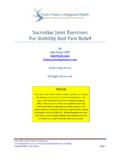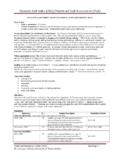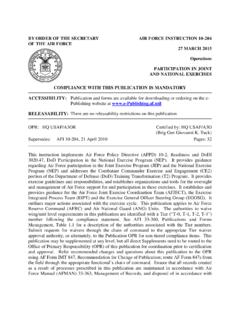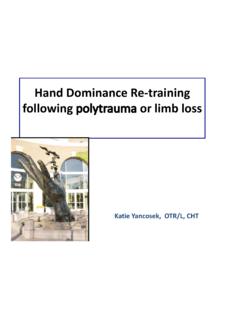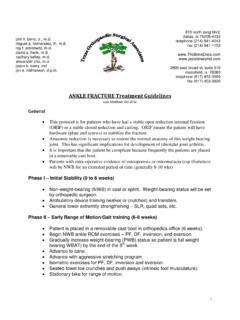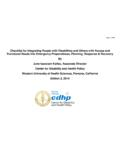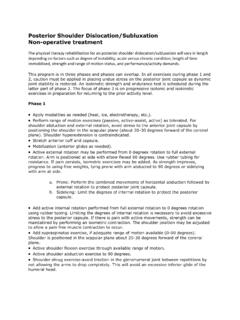Transcription of INFANT RANGE OF MOTION EXERCISES - Brachial …
1 INFANT RANGE OF MOTION EXERCISES . INFANT is lying on his/her back. Stabilize INFANT is lying on his/her back. Stabilize with shoulder with one hand and wrist with elbow and hold the wrist with other hand. the other. Lift the arm up to the level of Bend the elbow then straighten the elbow. the shoulder, thumb leading, elbow straight. INFANT is lying on his/her back. Stabilize with INFANT is lying on his/her back. Stabilize the one hand at the shoulder so that it doesn't forearm with one hand and hold the child's come up and hold forearm with the other hand with your other hand. Move the wrist hand. Lift the arm sideways away from from side to side.
2 Body, bring the arm straight out to the side. INFANT is lying on his/her back, elbow bent INFANT can be lying or sitting. Stabilize the and arm straight out to the side. Hold arm wrist with one hand and hold the child's straight out to the side and hold the forearm fingers with your other hand. Bend the with the other hand. Roll the forearm up, fingers, then straighten the fingers. then roll the forearm down. INFANT is lying on his/her back. Stabilize the INFANT can be lying or sitting. Hold the child's upper arm with one hand cupping the elbow wrist straight with palm open and hold the and hold the wrist with the other hand.
3 Roll fingers straight. Spread the fingers apart the forearm and hand up, then roll the gently, then bring them back together. forearm and hand down. Copyright 2005 All Rights Reserved INFANT RANGE OF MOTION EXERCISES page two Notes: i This is general listing of RANGE of MOTION EXERCISES for the upper extremity. i Each INFANT and injury is different. Please follow the specific instructions given to you by your doc- tor. i Having your physical therapist or occupational therapist train you and your family members on how to do RANGE of MOTION EXERCISES . If it's possible, video tape this seesion and refer back to it as needed.
4 Have your therapist review your technique once a month and adjust as necessary. i Do RANGE of MOTION EXERCISES with each diaper change. i Do the EXERCISES very gently. Closely watch the INFANT 's face for signs of pain or discomfort. i Do each MOTION 10 to 15 times and NOT to the end of the RANGE of MOTION . Move into the RANGE until mild resistance is felt and hold there for 30 seconds. Do not bounce into this stretch. Brachial PLEXUS INJURIES. The term "obstetrical palsy" was first used by Duchenne in 1872, and the description of upper root injury was de- scribed by Erb in 1874. The first surgical management of obstetric Brachial plexus injury (OBPI) was reported in the early 1900's although results were poor and mortality was high.
5 The majority of children with obstetric Brachial plexus injuries have risk factors for a difficult delivery such as large size, use of forceps or vacuum, and shoulder dystocia. The successful surgical treatment of Brachial plexus injuries awaited the development of microsurgical techniques in the 1970's. The modern surgical management of obstetric Brachial plexus injury is generally based on the studies of A. Gilbert and J. Tassin in the early 1980's in France. Tassin followed 44 children with OBPI for a period of 5 years without surgery in order to determine the natural history of the injury. Based on this study, Gilbert and Tassin proposed sev- eral indications for surgery: i When the biceps and deltoid recover by 1 to 2 months, a full recovery is likely and no surgery is indicated.
6 I When the biceps and deltoid recover by 3 to 4 months, a reasonable outcome is likely and no surgery is indicated. i Poor outcomes result if recovery begins after 3 to 4 months, and surgery is indicated. We basically follow these principles at The Nath Brachial Plexus Institute, although we do tend to wait until 4 or 5. months of age before recommending surgery. In our experience, this will allow maximum spontaneous recovery without losing time before muscle atrophy. Gilbert and Tassin also studied the functional outcome of another group of children following surgery when com- pared to the untreated 44 described by Tassin.
7 Their conclusion was that surgery, including nerve grafting and neu- rolysis (removal of scar), did result in significant improvement in function. Over 1200 children and adults have un- dergone primary surgery, with Dr. Nath, on the injured nerves, and virtually all have shown improvement with no loss of function. The results we have witnessed are even superior to that of Gilbert and Tassin. The concept that surgery will improve function in OBPI has been supported in many other studies worldwide. At The Nath Brachial Plexus Institute, we believe strongly that surgical intervention in appropriate cases will maxi- mize movement and sensation in the affected arm and hand.
8 We believe that the key to our success is in careful selection of appropriate patients and timely surgical intervention with the latest techniques in nerve reconstruction. INFANT RANGE OF MOTION EXERCISES page three LONG TERM OUTCOME. Brachial plexus injuries cause severe functional deficits in the affected extremity. The full extent of the arm and hand deficits may not be known for several years. Additionally, upper body posture may be altered as a result of compensatory maneuvers used to deal with poor po- sitioning of the shoulder and arm. "Many parents have been told that "95% of these injuries get better without treatment".
9 Dr. Nath's 9 years of experi- ence, over 5,500 evaluations and over 4,000 surgeries on children and adults with obstetric Brachial plexus injuries has led us to believe that this estimate is overly optimistic. A recent landmark report from the Children's Hospital at the very well respected Karolinska Institute in Stockholm, Sweden evaluated 105 children for functional outcome at 5 years of age following obstetric Brachial plexus injury (Sundholm LK, Eliasson A-C, and Forssberg H. Obstetric Brachial plexus injuries: assessment protocol and func- tional outcome at age 5 years. The Swedish study evaluated motor and sensory functions as well as the overall use of the affected limb.)
10 The re- sults indicated that "the eventual outcome from in upper-plexus lesions is more complex than is commonly be- lieved". Occupational Therapists and a physician specializing in movement problems of children determined these outcomes. The findings are quite compelling and very much in agreement with what we see in our clinic: i Children with no apparent deficits in shoulder, biceps or hand function by 3 months of age: 70% full recovery by age 5 years. i Children with remaining deficits in shoulder, biceps or hand function by 3 months of age: 5%. full recovery by age 5 years. It is important to understand the meaning of these results: even in the best case scenario, where no obvious deficits remain by the age of 3 months, fully 3 out of 10 children will have significant functional deficits by the age of 5 years if untreated.
